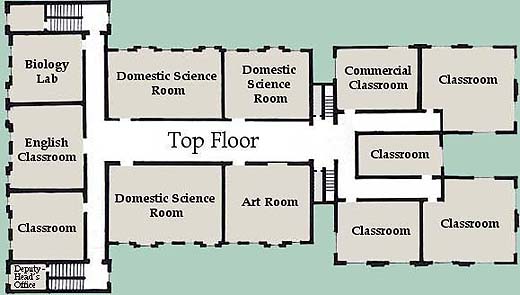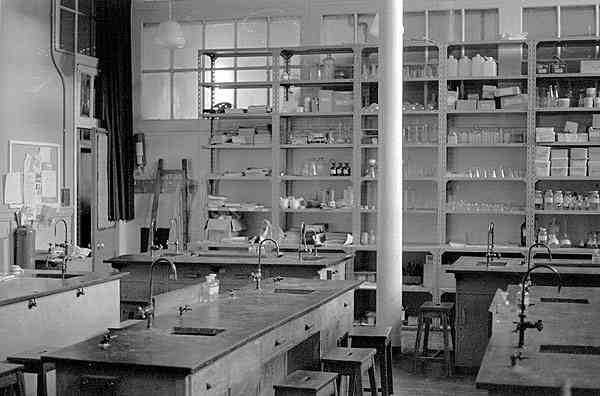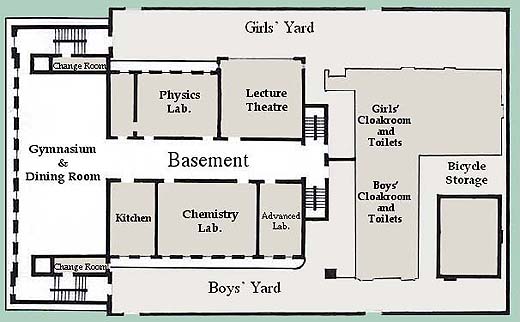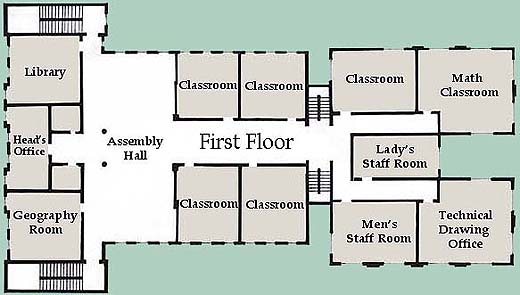|
The floor plans below are based
entirely on memory and guess work. If you know that I have made
errors in the plans please set me straight and I will make the changes.
  The two small rooms at the very top of the front stairways were originally the men and women teachers' staff rooms. When the staff moved into new quarters in the extension, these little rooms were given new roles. I remember that one of them was used by W. C. Martin, the Deputy Head. The top floor of the extension was devoted to classrooms. I clearly remember that one of them was equipped with desks that contained typewriters. I suspect that in fact the classroom I have marked as the commercial classroom extended the full length of that side of the building. When you reached the top floor on the back stairway and turned left (as a boy) the first room on your left was the Art Room. This was Mr. Quigley's room and for a short period of time Harold Riley, the famous Manchester artist, taught classes in that room. As far as I remember it, the rest of that corridor was the realm of the girls. Within those rooms, that we hardly ever entered, were cookery and needlework rooms. I went in there once when the 6th form girls entertained the 6th form boys to a "Do" - I think at Christmas. Right at the end of the corridor was a classroom used for English. Behind the door was a large book case which housed a library of books for younger students to borrow. This room was also used as a "sandwich room" for those students not brave enough to face school dinners. I remember supervising the room as a prefect. Next to that room was the Biology Lab, but it also functioned as a classroom for other subjects. I remember taking 1st year history in there with Mr. Woodhead as the teacher. I can't remember much of what we studied but I remember being amazed at this formidable man being so funny. Back along the corridor at the top of the back stairway were two small rooms used to store supplies like notebooks. Close to the one on the Art Room side was a tall cupboard standing against the wall. In the 1963-65 years that cupboard was the exclusive domain of the tiny number of geology students being coaxed through A Level Geology by Mr. Anne Dawson, a wonderful teacher who had the patience of a saint. The cupboard contained our growing collection of geological samples, some purchased and some gathered on our field trips. The cupboard was padlocked but John Fell and I spent many "idle" moments rummaging through it - in my case in a vain attempt to try to learn how to identify them.  
I started out at Ardwick Tech in Form 1C, with Mr. Cox as my form teacher. We occupied the classroom next to the hall on the boys' side of the school. The room next to it was the domain of Mr. W. C. Martin, deputy-head and math teacher. He walked the hallways of Ardwick Tech in his signature white coat and struck fear into the heart of the toughest characters. I was to discover as time passed that his bark was worse than his bite and he was a big help to me in my last few years at the school. I remember, as a first year, taking geography with Miss Kellet in the room across the corridor from Mr. Cox's room. She was an excellent teacher who unfortunately died just months before I started publishing this web site. One of the first messages I received about it was from the daughter of a close friend of hers. On the first floor of the extension were the two new staff rooms and as hard as it is to believe today, I'm sure that they continued the tradition in 1959 of having a Mens' Staff Room and a Ladies' Staff Room. Behind the Staff Room was the Technical Drawing Office, the home base of Les Holding, who I will always remember because apart from being a good teacher he was "cool" and not to many of the staff could be called that. His car was particularly cool, a beautiful Riley saloon. Across the extension from the Drawing Office was a room used for mathematics and when we moved into the extension in 1959 it was Miss Pearson's room. She is also famous for finding one of the first defects in the shiny new building when a struggle to adjust the venetian blinds resulted in the whole blind falling on her head. The Assembly Hall was obviously the main feature of the first floor. Here, as the name implies, we held our morning assemblies. It was also the venue for plays, concerts, harvest festivals and Remembrance Day services. On the brick pillars at each side of the corridor leading from the hall, were our war memorials. When plays were presented, a stage was constructed across the corridor and full use was made of the sliding partition walls of the adjoining classrooms. The cast and stage crews could use the classrooms as dressing rooms and staging areas for scenery and props. On the Devonshire Street side of the hall was Harry Johnson's geography room, Donald Woodhead's office and the school library. I took A Level Geography so I spent a lot of time with Harry Johnson and admired his quiet good nature. I remember him telling me a story about his experiences in the R.A.F. He was a navigator in training, flying sorties in Canada. They would fly long distances over the Canadian wilderness, something that was particularly hard on one flight when he forgot to take the maps. The library doubled as an english classroom on occasion but was usually open at lunch times for those of us who wanted to sit around somewhere warm and have a crafty chat. When the school was first built, the Head's office occupied all of the space between the geography room and the library. In 1957 what had been one large office and a stock room was transformed into a Headmaster's office, a secretary's office, an office for the Senior Mistress and Night School Principal, and a waiting room. Apparently up until this time the Senior Mistress had operated from a desk in the hall. The secretary's office was occupied by Helen Leach. She was a friend of a friend of my sister's and she was there to greet me with a smile when I arrived at the school and was a friendly face for all the years I was there.    There was no basement in the new extension. I cannot remember exactly how it was laid out on the ground level but I do remember that at the end closest to the original building you could walk in under the shelter of the building. There was a toilet and a cloakroom at that end close to the entrance doors. I assume that this was the case on the other side although I never entered the forbidden territory of the other side. I also remember that on the boys' side you could walk along a passageway into a small courtyard to store your bike during the day. Since the original building had no ground floor, you could only go up to the first floor or down into the basement when entering the school. From the extension end the basement corridor ran towards the gymnasium between the lecture theatre and the physic's lab on the right and the advanced lab, chemistry lab and kitchen on the left. In my day the physics teacher was Mr Hughes and Mr. Barnett taught chemistry. The change rooms for the gym were part way down the staircase to the basement. The gym was equipped with typical climbing equipment that swung out from its storage position against the wall. At lunch time the gym was used as a dining room. As Donald Woodhead points out in his description of the school, it was built on a very restricted site between rows of terraced houses. There was little room for growth and nowhere to go for sporting activities. For that reason, we were often on the go during a typical week between various other venues near and far. Down Devonshire Street and across Stockport Road was a church building we knew as the Octagon, a name which described its appearance. We used rooms in the Octagon for classroom subjects and wasted part of each class just getting to and from it. My memory of this grim place was of freezing to death in what seemed to be an unheated building. Woodwork and metalwork needed shops but there was no room for them at the main school. so we walked to a place called Bank Meadow which was just across Ashton Old Road near Pin Mill Brow. Messers. Allardice, Chapman and Rees were in charge out there. When we had sports, we always had a whole morning or afternoon because it involved a bus ride out to the recreation grounds at North Road in Miles Platting which we shared with the Greenmount Secondary School. The grounds were next to the Monsall Isolation Hospital and across from the Dogs Home. This was where Manchester United, in its earliest years, played its games. Unfortunately, none of this rubbed off on me. I always had great kit but no skill. There was a pavillion at North Road with change rooms but often we changed on the bus travelling through the city center. Have you ever tried to get long pants on over football boots on a rolling double-decker? Mind you I suppose it would have been smart to take the boots off first! |
